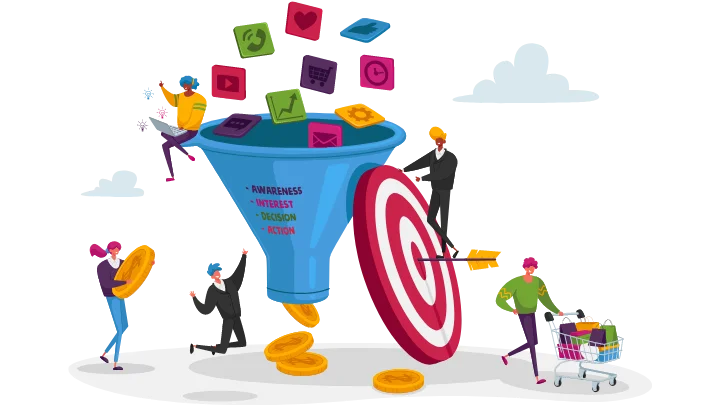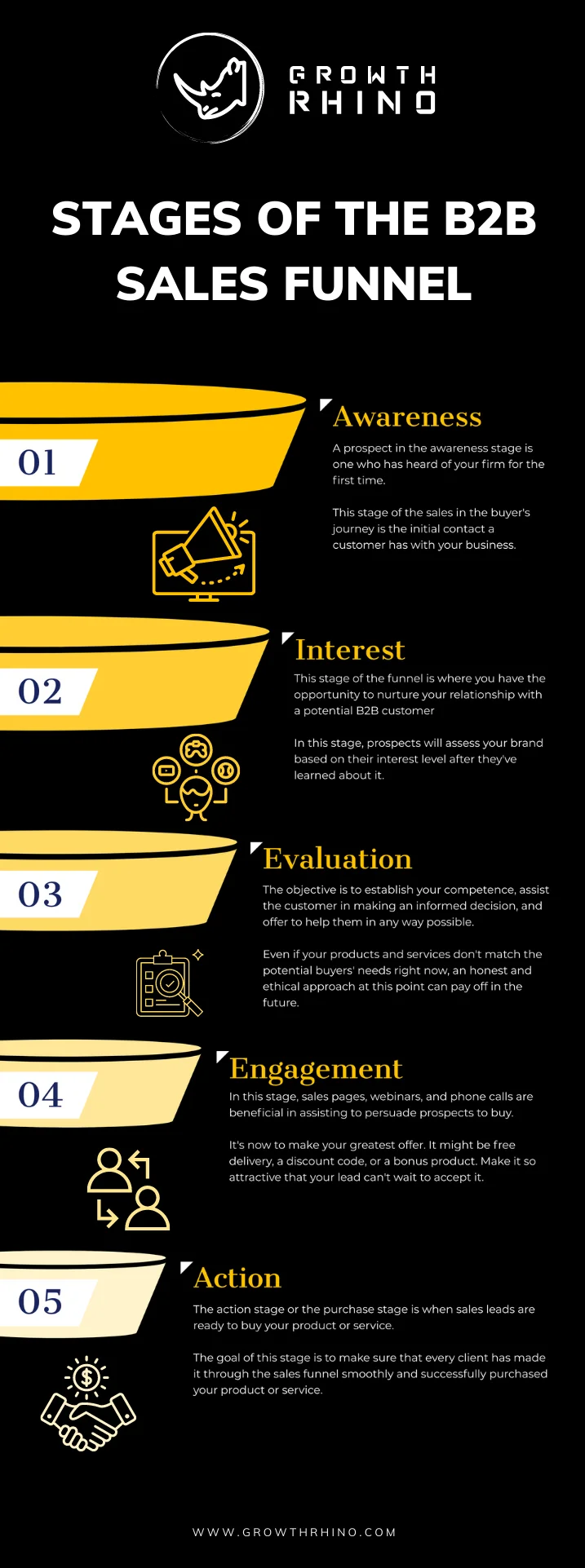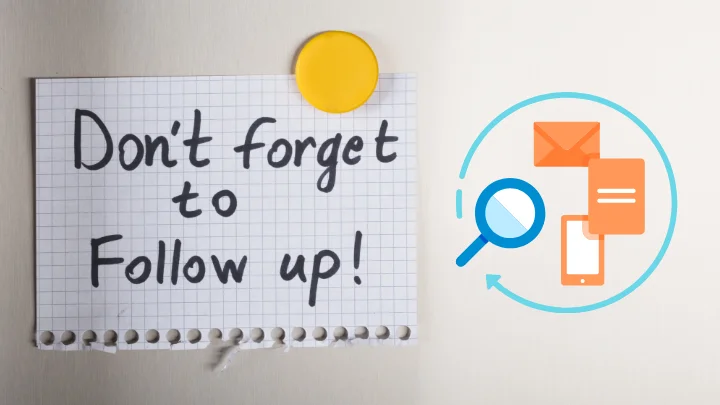
Many businesses have a hard time building sales funnels that convert because they are not building the funnel correctly, or they are building it in the wrong order.
In this article, we will cover everything you need to know about building your own B2B Sales Funnel. We'll go over what it is and why it's important for your business, as well as the different stages of building an effective one!
What is a B2B Sales Funnel?
A B2B sales funnel is a process that prospective customers go through before purchasing from your business. It is a process that tracks how your quality leads are collected and moved through the various phases of engagement until they make a purchase or exit the funnel.

It typically starts with building awareness and goes all the way to building lasting relationships. The B2B sales funnel is concerned with the activities that salespeople take throughout the selling process, as well as the potential for income at any particular moment.
If you have ever been shopping online for something where there were multiple steps in order to view the product page, those are each individual stage of the sales funnel.
Why is Building a B2B Sales Funnel Important for Your Business?
The goal of a sales funnel is to reveal what potential customers are thinking and doing at each stage of the purchasing process. These insights allow you to invest in the most appropriate sales and marketing efforts and channels, develop the most relevant and appropriate messaging throughout each step, and convert more prospects into paying clients.
A well-thought-out and executed B2B sales funnel will help you build relationships with leads who are ready to purchase, while they're still engaged in what you have to offer! If done correctly, it can be a source of revenue for your business that will continue long after you've closed the sale.
What is the Difference Between a Marketing Funnel and a Sales Funnel?
The difference between building a marketing funnel vs building a sales funnel is simple: one focuses on leads, while the other focuses on new customers.
A marketing funnel is a model that illustrates how a person comes to know about your brand and eventually makes a purchase. To understand their clients' demands at each step, businesses employ marketing funnels to optimize their advertising efforts and increase revenue.
The sales funnel is a marketing concept for the path that potential customers take to make a purchase. The sales funnel aids businesses in better understanding and visualizing their sales process while also tracking overall conversion success between each step of the funnel.
A sales funnel is a set of actions that leads to a sale. It may include anything from advertising to blogging to social media outreach to email campaigns to conversion rate optimization (CRO), search engine optimization (SEO), retargeting, copywriting, SMS marketing, split-testing, and/or a variety of other possibilities.
What are the different stages of the B2B Sales funnel?

The Sales Funnel Stages:
Stage 1: Awareness.
Stage 2: Interest.
Stage 3: Evaluation.
Stage 4: Engagement.
Stage 5: Commitment/Purchase
Stage 1: Awareness:
The first of the sales funnel stages, located at the top of the funnel is known as the "awareness" level, because it marks the start of people recognizing your product or service. This stage of the sales in the buyer's journey is the initial contact a customer has with your business.
They may hear about you from your marketing, social media, and even word of mouth. Driving awareness means building trust and creating interest in what you have to offer.
Before you can sell anything, you must first make people aware of your products or services. Leads in the middle and lower phases of the sales funnel are those you should pay the closest attention to since they've gone beyond awareness into interest.
A prospect in the awareness stage is one who has heard of your firm for the first time. They might have clicked on one of your advertisements, read your blog posts, come to your website via a Google search, or heard from a colleague about your product or service.
Here are other ways to build awareness:
- Social media posts and promotions
- Guest posting
- Whitepapers and webinars
- Infographics
The digital landscape provides ample opportunities for businesses to engage their customers at every touchpoint, from social media marketing campaigns on Facebook or Twitter, banner advertisements across different websites, email newsletters promoting new products/services – the list goes on.
Stage Two: Interest:
The next stage is the interest stage. This stage of the funnel is where you have the opportunity to nurture your relationship with a potential B2B customer and build trust by providing relevant information that makes them feel comfortable with moving forward – whether it’s requesting further details or building an advanced case for purchase, engagement at this level marks the beginning of building a relationship.
In this stage, prospects will assess your brand based on their interest level after they've learned about it. They'll consider the problem they're trying to address and do competitive research to ensure that your products and services are the best options.
Stage Three: Evaluation:
During the evaluation stage, you've successfully grabbed the buyer's attention. It's now time to concentrate on demonstrating how your solution is ideal for their requirements.
When consumers reach the interest stage in the sales funnel, they're conducting research, comparing prices, and weighing their choices. This is when you should leap in with innovative material that assists them while nonetheless not selling to them.
This is also when leads should be informed if your solution isn't in their best interests, in order to further build trust. Even if your products and services don't match the potential buyers' needs right now, an honest and ethical approach at this point can pay off in the future.
The objective is to establish your competence, assist the customer in making an informed decision, and offer to help them in any way possible.
Stage Four: Decision:
The sales funnel's decision stage occurs when the prospect is ready to buy. He or she might be contemplating two or three alternatives, hopefully including you.
Armed with details and knowledge about your business, prospects will dig deeper into your pricing and packaging alternatives. In this stage, sales pages, webinars, and phone calls are beneficial in assisting to persuade prospects to buy. It's now to make your greatest offer. It might be free delivery, a discount code, or a bonus product. Make it so attractive that your lead can't wait to accept it.
Stage Five: Action:
The action stage or the purchase stage is when sales leads are ready to buy your product or service. During the purchase stage, a sales rep takes control and handles any last-minute questions or concerns. They help clients get through the sales funnel with ease by guiding them to make an informed decision about your product.
This means that you'll be working closely together throughout this process in order for it to go smoothly. The sales team should be the ones reaching out to sales leads via email or phone, not sales prospects.
The goal of this stage is to make sure that every client has made it through the sales funnel smoothly and successfully purchased your product or service. It is the most critical part of sales funnel management because it's where you get the chance to close sales leads, create brand loyalty and revenue.
How to Build a B2B Sales Funnel:
A well-designed sales funnel model can assist you in lead generation, fine-tuning the sales procedure, and detecting and optimizing client journeys.
A sales funnel model is an essential component of the business process, assisting you in developing a long-term approach for new and existing consumers. Sales funnel stages have 7 steps, so, let's look at how to construct a sales funnel one step at a time.
1) Understand what your customers want:
Understanding your customers' wants, needs, and desires is the first step to sales funnel success. Before you start building your sales funnels, it's important to understand what makes people want to buy.
It is also beneficial if the sales team actually discusses this with customers and prospects before moving on in order to ensure that they are targeting the right audience.
The more you understand about your customers, the better your sales funnel will perform. You're not marketing to everyone. You're marketing to people who are a good fit for what you offer.
How To Do It:
Start by creating buyer personas so you can further pinpoint your target audience. You might be surprised at how helpful this process will prove to be in the long run. Where do visitors click? When do they scroll? How long do people spend on a website? All of this data will assist you in developing your buyer personas.
Use social media monitoring tools that give you a birds-eye view of your audience and their behavior. Spend some time on the sales and marketing funnel tools to gain a deeper understanding of what works (and doesn't) for sales and marketing process improvement.
Aside from site statistics, you might want to consider requests for proposals (RFPs), conversion rates, mailing lists, and other ways customers interact with your business. Understanding when people take action allows you to market to them more effectively. Then you'll be more equipped to build an effective sales funnel that will bring in leads, nurture relationships with them, and finally, close the sales process.
2) Capture your audience’s attention:
So, how do you capture your prospect’s attention? To capture your prospect's attention, sales teams have to identify what their customers want. Personalized messaging that genuinely matters, delivered at the perfect moment, is what also works.
The only way to build a sales funnel that works is if people are drawn into it. This entails placing your material in front of your target audience. Take the organic approach and publish a lot of material on all of your platforms. Infographics, videos, and other sorts of content can help you diversify.
If you're prepared to spend additional money, place a few advertisements. The best location to run those ads is determined by where your target audience hangs out. If you're selling to businesses, LinkedIn advertising may be the ideal answer.
In many sectors, it might take numerous visits for a prospect to feel comfortable with your firm and product and make their first purchase. Moving a lead from the awareness stage to the consideration stage might take months. That is why sales are not simply about selling; it's also about marketing.
3) Nurture relationships:
Customers come and go - this is the natural course of things for all businesses. Customers may flow into your sales pipeline at any time, and having a successful nurturing approach can help strengthen relationships.
Nurturing relationships should be designed to offer mutually beneficial exchanges (meaning, giving away something in order to add value, enhance abilities, or expand possibilities) without the desire for a sale. You run the risk of losing your potential customers' attention if you engage with leads too soon or late.
What To Do:
Shifting from top-of-funnel to highly targeted, mid-to-lower level content will allow you to provide more relevant and valuable content for current and potential consumers. Email marketing is another approach to nurture relationships.
Despite the fact that methods of communication evolve, as seen with mobile devices and social media, email marketing continues to be an effective channel for nurturing leads and generating sales.
Finally, focusing on the demands of a client, especially by segmentation and customization, can help to build trust and sustain relationships into the future.
4) Prepare for the sales meeting:
First impressions seldom seal the deal - your prospect will generally need more convincing to become a paying customer. But, first impressions do matter, and they frequently reveal how likely your prospect is to complete the sales funnel stages.

That is why to create a better impression, you must have all of the required information on hand. Combine your study data, relevant content, RFP information, website and communication activity, as well as any consumer data from your CRM system to create a comprehensive knowledge base.
Sales meetings are an important component of the sales process because they're designed to help you develop products and services while also developing relationships, identifying gaps and needs, and describing product advantages.
What to do:
To contact, engage with, and close with clients, sales reps need flexibility and innovation. That's why standardizing the sales process can significantly improve your sales funnel, pipeline, and productivity. It's not a script or a sales playbook; it's a framework that you can adjust and modify to get where you want to go.
Some of these activities will be repeatable - you may automate them and allow sales reps to focus on developing relationships and increasing sales. As a result, you'll be able to address their problems once and for all by creating a tailored product for them.
5) Follow up regularly:
You might lose leads if you don't follow up. Aside from instructing your salespeople to follow up on a regular basis, you may set alerts or calendar reminders in your email software to keep track of them.

The follow-up procedure also helps you sell more. You can remove prospects who have gone silent after many calls, responded with an out-of-office response, or requested to connect at a later time. For leads that progress forward, you'll know where they are in the funnel and how close they are to closing a deal.
It's important to keep in touch with your existing customers. You can find out how they liked the product, get testimonials, or encourage them to share positive things about you on social media.
6) Close the deal:
Closing the deal is the final stage of building a B2B sales funnel. It's all about closing the sale at this point, and you're either making it or not. Listen carefully to your customer to understand what might be holding them back.
Almost half of the modern B2B purchases are made by leads that get support all the way to the finish line, so your lead nurturing efforts are also critical.
There are three primary approaches to gain buyer commitment and minimize difficulties throughout the closing procedure:
a) Align your objectives according to your priorities:
Confirm any claims made in previous conversations with your clients, from calls to meetings to correspondence. This will assure the buyer that you grasp their pain points and remember their wants. This will mean that you are listening to their needs. You establish rapport and verify you are on the same page by requesting an assurance.
b) Secure commitment:
Reiterate the key advantages of working with you and how your solution addresses their most important problems. At this stage, you may look for potential difficulties and possible solutions in the future, or ask them for any concerns they might have.
c) Keep the connection going:
Even after you've received a commitment, your job isn't finished yet. Before you sign the contract, find out whether any additional decision-makers are included or if there are any contract issues to resolve.
This stage in the buyer's journey requires research and conversations with your decision-makers to determine the issues they are facing and how to tailor yourself as a solution.
With any large purchase decision, it’s natural to get doubts (or buyer’s remorse), so remain available to reassure the customer if they have any questions after the deal is done. By keeping communication lines open, you can maintain a positive relationship that lasts well into the future.
7) Optimize your sales funnel:
When you optimize your sales funnel it means keeping your marketing and sales free of leaks that could lead sales away. To keep your sales funnel full, you must monitor each stage to ensure the steps are working as intended.
If leads aren’t converting into sales or customers at a rate you expect, look for problems with any part of the sales process and work on those first before considering changes elsewhere. To better meet their demands at each stage, your sales funnel must give them a wide range of solutions.
As the funnel gets narrower, your lead requires more detailed information to understand your product. Whitepapers, guides, webinars, and case studies will be looked at by them. Regardless of where they are in the funnel, leads must be engaged, interested, and make their way down to deal closure.
Conclusion:
The Definitive Guide to Building a modern B2B Sales Funnel is designed for entrepreneurs who need guidance on how to create and optimize a B2B sales funnel that will drive more qualified leads, nurture relationships with prospects, and close deals.
This guide offers practical tips from experts in the field of digital marketing as well as strategies from experienced professionals at some of today's leading companies.
We hope you find it helpful! If you want help building your own effective funnel or optimizing an existing one, we’re happy to provide consultation services tailored specifically for your company's needs. Contact us now if this sounds like something you might be interested in!
